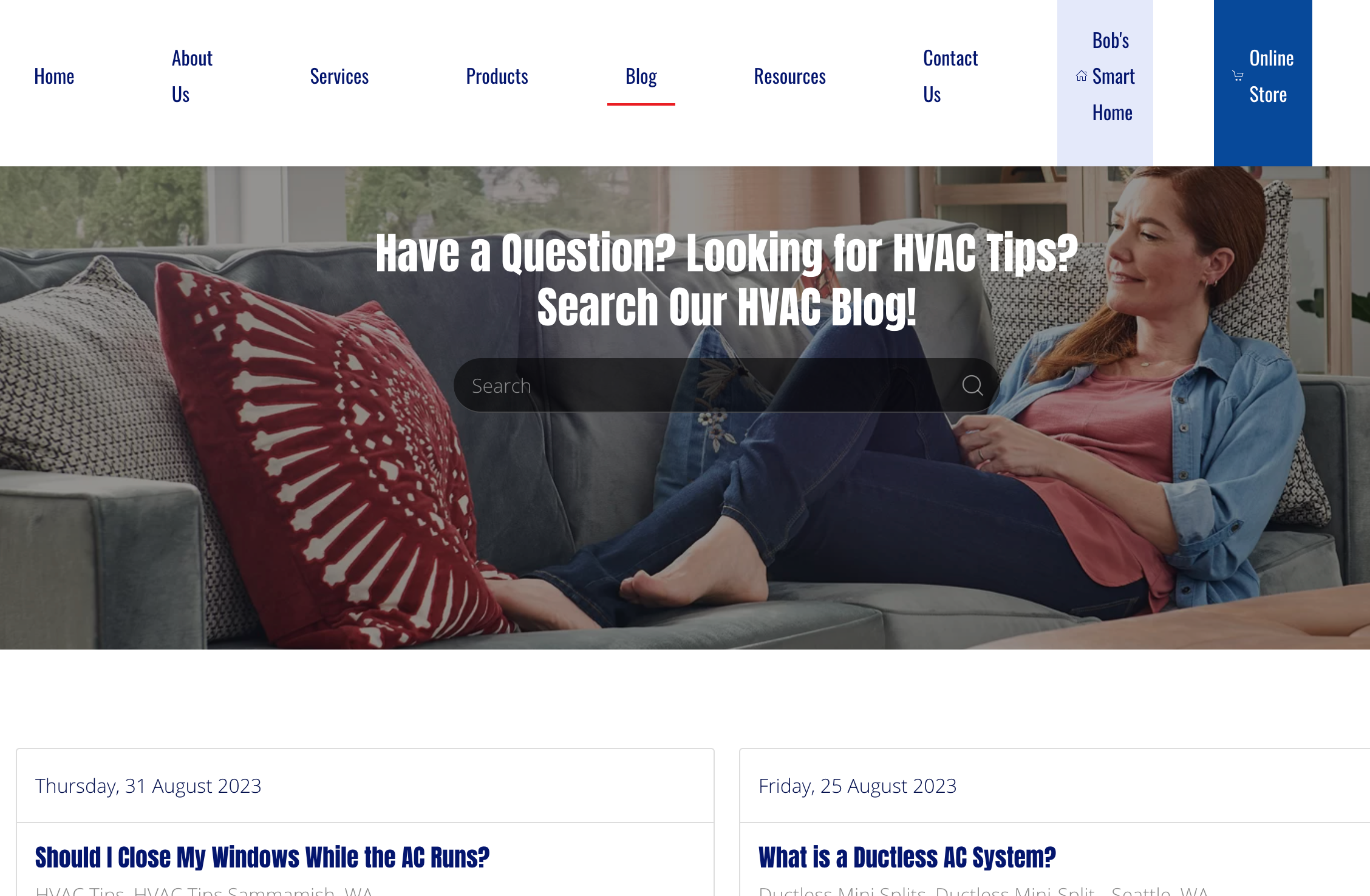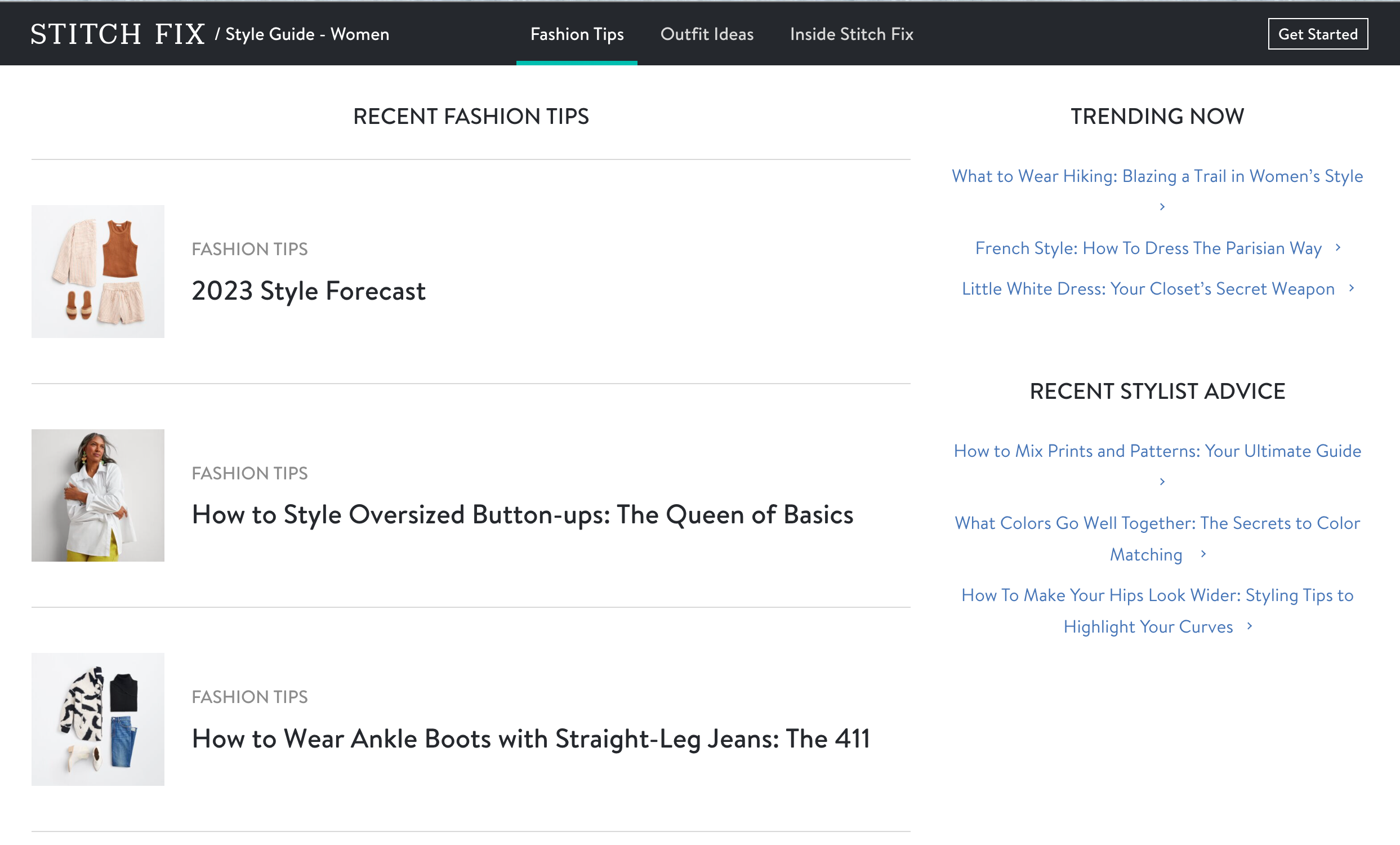There are countless types of industries who are improving their sales numbers with digital marketing alone. The right landing page or the perfectly designed website can make all the difference in a professional-looking business. But the one thing industries may skip is developing a blog. However, having a blog page is not just for food bloggers or beauty bloggers trying to sell products.
If you’re curious if your business can benefit from a blog page, the answer is yes. Some businesses think their industries don’t need a blog, but it’s only been proven to increase website traffic.
Table of Contents

Benefits of Having a Blog
What can you expect by implementing a blog page on your site? Businesses mainly want to focus on selling products or services through their blog articles, which is possible, but blogs can do so much more, like:
- Show your expert in your industry
- Increase website traffic
- Improve placement of your site on the search engine results page (SERP)
- Target specific clients or customers
- Increase brand awareness
- Build stronger customer relationships
- And, of course, make sales
Ideas for Blogs by Industry
Now it’s time for businesses to learn how they can leverage a blog page for their business. It doesn’t matter if you are a contractor or have an e-commerce website as well as a brick and mortar store, a blog can only improve your marketing efforts and likely increase your ROI. Besides, blogs are a relatively cheap endeavor to take on.
For Law Firms
Law firms, similarly to real estate agents and agencies, can showcase their services and specialties through a blog. They can also focus on giving site visitors information on specific types of cases or the legal process to help them decide to contact the law firm for services.
1. Establish Clear Goals and Objectives
Before diving into customization, it's essential to define your blog's purpose. Common goals for law firm blogs include:
- Demonstrating Expertise: Showcase your legal knowledge and experience to build trust with potential clients.
- Client Education: Provide informative content that answers common legal questions, helping clients better understand their situations.
- Lead Generation: Use the blog to capture leads by offering valuable resources, such as eBooks or consultation requests.
- Content Promotion: Drive traffic to your main website, specific practice area pages, or attorney profiles.
The example below shows a great layout of a blog page for a law firm. The different categories showcased on the right of the page is a great way to highlight the law firm's specialties as well as inform their site visitors about particular topics.

Photo Credit: lovell-law.net
2. Choose a Professional Design
Your blog's design is the first impression visitors will have of your law firm. It's crucial to opt for a clean, professional, and user-friendly design. Here are some tips:
- Branding: Ensure your blog's colors, fonts, and logo align with your law firm's branding.
- Mobile Responsiveness: With a significant portion of internet traffic coming from mobile devices, your blog must be responsive and accessible on all screen sizes.
- User-Friendly Navigation: Make it easy for visitors to find relevant content by organizing your blog into categories and using a clear menu.
- High-Quality Images: Use high-resolution images and graphics to enhance the visual appeal of your blog.
3. Tailor Content to Legal Audiences
The content you create for your law firm's blog should cater to the interests and concerns of your target audience. This means producing informative and authoritative articles that address legal topics. Consider the following:
- Legal Updates: Keep your audience informed about changes in laws, regulations, or significant court decisions that might affect them.
- How-To Guides: Create step-by-step guides for common legal processes or procedures relevant to your practice areas.
- Case Studies: Share success stories or case studies from your firm to demonstrate your expertise and problem-solving abilities.
- FAQs: Compile a list of frequently asked questions and provide detailed answers.
- Client Testimonials: Feature testimonials from satisfied clients to build credibility.
4. Showcase Attorney Profiles
Highlighting your attorneys and their expertise is a significant customization for law firm blogs. Each attorney should have a dedicated profile page that includes:
- Professional Bio: Provide a comprehensive biography, including educational background, experience, and areas of expertise.
- Client Testimonials: Showcase feedback from clients who have worked with the attorney.
- Awards and Recognition: Highlight any awards, recognitions, or publications the attorney has received.
- Contact Information: Make it easy for potential clients to get in touch with the attorney.
5. Encourage Interaction
Engagement with your audience is crucial. Allow for comments on your blog posts and encourage readers to ask questions or share their thoughts. Respond promptly to comments and questions to demonstrate your commitment to client engagement.
6. Use Legal Disclaimers
Due to the sensitive nature of legal topics, it's essential to include appropriate legal disclaimers on your blog. These disclaimers should clarify that the blog content does not constitute legal advice and encourage readers to consult an attorney for their specific situations.
7. Promote Ethical Blogging Practices
Lawyers must adhere to ethical guidelines when blogging. Avoid making unsupported claims, ensure client confidentiality, and refrain from disclosing sensitive client information. Familiarize yourself with your jurisdiction's rules of professional conduct to ensure your blog complies with legal ethics.
For Contractors
Contractors can be independent architects, construction builders, plumbers, independent electricians, and any other type of home service. A blog can be extremely helpful in convincing site visitors to book a service with these kinds of businesses or individuals.
1. Define the Point of Your Blog
The first step in customizing your blog is to establish clear objectives. Knowing why you're creating the blog and what you hope to achieve will guide your customization efforts. Common goals for contractor blogs include:
- Showcasing Expertise: Highlight your skills, experience, and knowledge to establish credibility and trust with potential clients.
- Educating Clients: Provide valuable information on construction processes, materials, and project planning to educate clients and help them make informed decisions.
- Lead Generation: Use the blog to capture leads by offering resources like guides, project estimates, or consultation requests.
- Project Portfolio: Display your past projects and their success stories to demonstrate your capabilities.
This blog example has a different approach by giving site visitors the option to search for a topic relating to heating and air conditioning.

Photo Credit: bobsheating.com
2. Choose a Suitable Design
Your blog's design should reflect professionalism, trustworthiness, and user-friendliness. Consider these design tips:
- Branding: Maintain consistency with your company's branding by using the same colors, fonts, and logo.
- Mobile Responsiveness: Ensure your blog is fully responsive and functions seamlessly on mobile devices.
- Easy Navigation: Organize your blog logically with clear menus and categories to help visitors find the content they're looking for.
- High-Quality Imagery: Use high-resolution images of your work to visually represent your expertise and showcase your projects.
3. Tailor Content to Your Target Audience
Your content should align with the interests and needs of your target audience. Create articles that address construction-related topics, including:
- Project Updates: Share progress updates, challenges faced, and solutions implemented for your ongoing projects.
- How-To Guides: Offer step-by-step guides on various construction tasks or DIY projects for homeowners.
- Material Insights: Educate your audience about different construction materials, their benefits, and best practices for usage.
- Safety Tips: Provide information on construction safety measures and guidelines.
- Client Testimonials: Include feedback and testimonials from satisfied clients to build trust.
4. Showcase Your Projects
As a contractor, your work speaks volumes about your expertise. Dedicate a section of your blog to showcase your past projects. For each project, include:
- Project Description: Provide a brief overview of the project, including the scope, location, and client requirements.
- Before-and-After Photos: Share high-quality images that demonstrate the transformation achieved through your work.
- Client Testimonials: Include feedback from clients who were satisfied with the project's outcome.
5. Encourage Interaction
Allow comments on your blog posts and encourage readers to ask questions or share their experiences. Respond promptly and thoughtfully to comments and questions to foster a sense of community and trust.
6. Implement Contact Options
Make it easy for potential clients to get in touch with you. Include contact options such as:
- Contact Form: Offer a straightforward form for inquiries, estimates, or consultation requests.
- Phone Number: Display a visible phone number for immediate contact.
- Email Address: Provide an email address for inquiries and support.
7. Address Legal and Regulatory Requirements
Given the highly regulated nature of the construction industry (or plumbing and other home services), ensure your blog complies with all relevant legal and regulatory requirements. This may include disclaimers, permits, or licenses, depending on your jurisdiction.
For E-commerce Businesses
There are so many e-commerce stores online nowadays. Let’s explore how to customize a blog specifically for e-commerce businesses.
1. Decide What Your Blog's Goals Are
Before diving into customization, you need to establish clear objectives for your e-commerce blog. Common goals for e-commerce blogs include:
- Product Promotion: Use the blog to highlight specific products or product categories, educate customers about their benefits, and drive sales.
- Brand Building: Share your brand's story, values, and mission to connect with customers on a deeper level and foster brand loyalty.
- Content Marketing: Attract and engage potential customers by providing valuable content related to your niche, such as how-to guides, product reviews, or industry insights.
- Customer Engagement: Encourage interaction with your audience through comments, social sharing, and subscriptions.
TruVISIBILITY's landing pages and other web page templates are great inspiration for any page on your site. You can change them any way you like to even match the style of your blog.
2. Choose a Visually Appealing Design
Your blog's design should be visually appealing, user-friendly, and align with your brand's aesthetics. Consider these design tips:
- Branding: Maintain visual consistency with your e-commerce website by using the same color scheme, fonts, and logo.
- Responsive Design: Ensure your blog is mobile-responsive to cater to users on various devices.
- Clear Navigation: Organize your blog's content logically with easy-to-navigate menus and categories.
- High-Quality Imagery: Use high-resolution images and graphics to make your blog visually engaging.
3. Tailor Content to Your Target Audience
The content you create should resonate with your target audience. In the context of e-commerce, this often means crafting content that addresses their interests, concerns, and shopping needs:
- Product Descriptions: Create detailed, informative product descriptions that help customers make informed purchase decisions.
- How-To Guides: Offer step-by-step guides on using your products, caring for them, or solving common problems related to your niche.
- User-Generated Content: Showcase customer reviews, testimonials, and images of your products in action to build trust.
- Blog Categories: Organize your content into relevant categories, making it easier for visitors to find information about specific products or topics.
Stichfix is a company that sells clothing but also chooses styles for clients. Through styling they can show customers what looks good on them and allow them to purchase the items they receive in their box each month. This blog is a great idea for them since site visitors will be looking on how to style themselves.

Photo Credit: stitchfix.com
4. Optimize for SEO
Search engine optimization (SEO) is essential for making your blog discoverable. Conduct keyword research to identify relevant keywords related to your products and industry. Incorporate these keywords naturally into your blog posts, headings, and meta descriptions. Ensure your blog loads quickly, and optimize images for faster loading times. Implement schema markup to enhance your blog's visibility in search engine results.
5. Showcase Featured Products
To drive sales, consider featuring products prominently on your blog. Include:
- Product Galleries: Create visually appealing galleries that display your products with high-quality images, descriptions, and prices.
- Call-to-Action (CTA) Buttons: Include clear and compelling CTA buttons that direct visitors to product pages.
- Product Spotlight: Regularly highlight specific products with in-depth posts, reviews, and testimonials.
6. Encourage Engagement
Engaging with your audience is crucial. Allow comments on your blog posts and actively encourage readers to share their thoughts, questions, and experiences. Respond to comments promptly to foster a sense of community and build trust.
7. Implement E-commerce Features
Consider integrating e-commerce features directly into your blog, such as:
- Shopping Cart Integration: Enable visitors to add products directly to their cart from your blog.
- Related Products: Suggest related or complementary products within your blog posts or on product pages.
- User Reviews: Allow customers to leave reviews and ratings directly on your blog, enhancing the credibility of your products.
8. Offer Exclusive Discounts and Promotions
To incentivize blog readers to become customers, periodically offer exclusive discounts or promotions that are accessible only through your blog. Highlight these offers in blog posts and on dedicated promotional pages.
9. Social Media Integration
Integrate social media sharing buttons on your blog posts to encourage readers to share content across their social networks. Additionally, maintain an active presence on your own social media channels, sharing your blog content and engaging with your audience there.
The Medical Field
Let’s dive deeper into how you can customize a blog for a medical clinic, whether it’s a dermatologist's office, a hospital, a plastic surgeon’s office, or even a med-spa.
1. Define Your Blog's Purpose and Goals
Before diving into customization, it's crucial to establish clear objectives for your medical clinic's blog. Common goals for medical clinic blogs include:
- Patient Education: Provide valuable health information to empower patients and help them make informed decisions about their health.
- Practice Promotion: Showcase your clinic's services, expertise, and patient-centered care to attract new patients.
- Building Trust: Demonstrate your medical expertise and commitment to patient well-being, fostering trust among current and potential patients.
- Community Engagement: Encourage interaction and engagement with your local community through health-related discussions and events.
2. Design a User-Friendly Layout
The design of your blog should convey professionalism, trustworthiness, and user-friendliness. Consider these design tips:
- Branding: Maintain consistency with your clinic's branding, using the same color scheme, fonts, and logo.
- Mobile Responsiveness: Ensure your blog is fully responsive to cater to users on various devices, including smartphones and tablets.
- Clear Navigation: Organize your blog's content logically with easily accessible menus and categories.
- High-Quality Imagery: Use high-resolution images and graphics to make your blog visually appealing, while respecting patient privacy and confidentiality.
3. Create Relevant and Authoritative Content
Tailor your blog content to the interests and needs of your target audience—patients and individuals seeking reliable health information. Consider the following types of content:
- Health Tips and Advice: Provide guidance on maintaining a healthy lifestyle, managing chronic conditions, and preventing illnesses.
- Medical News and Updates: Share the latest developments in healthcare, such as breakthroughs in treatments or changes in medical guidelines.
- Patient Stories and Testimonials: Share success stories and experiences of patients who have benefited from your clinic's care.
- FAQs: Address common health questions and concerns, helping patients find answers online.
4. Optimize for SEO and Health Literacy
Search engine optimization (SEO) is essential to make your medical blog discoverable. Conduct keyword research to identify relevant healthcare-related keywords and phrases. Use these keywords naturally in your blog posts, headings, and meta descriptions. Ensure your blog loads quickly, and images are properly optimized. Focus on health literacy by using plain language to make your content easily understandable for a broad audience.
5. Patient Privacy and Confidentiality
As a medical clinic, you must prioritize patient privacy and confidentiality. Avoid sharing personal patient information or case details in your blog posts or comments. Always obtain appropriate consent before sharing any patient stories or images, even in an anonymous form.
6. Entice Patients to Interact or Contact You
Engagement with your patients is vital. Allow comments on your blog posts and actively encourage patients to ask questions or share their experiences. Respond promptly and professionally to comments and questions, demonstrating your clinic's commitment to patient care.
7. Offer Online Appointment Booking
Integrate online appointment booking options into your blog to streamline the patient journey. Ensure that the booking process is user-friendly and secure, and clearly communicate your clinic's contact information.
8. Adhere to Medical Ethics and Regulations
Maintain strict adherence to medical ethics and healthcare regulations. Avoid making unsupported claims, provide accurate medical information, and include appropriate disclaimers in your content. Familiarize yourself with your jurisdiction's healthcare regulations to ensure compliance.
9. Stay Updated on Medical Trends
In the rapidly evolving field of healthcare, it's essential to stay updated on medical trends, breakthroughs, and emerging health concerns. Incorporate timely and relevant topics into your blog to demonstrate your clinic's commitment to providing up-to-date healthcare information.
Conclusion
Blogs, as you can see, can be easy and fun to implement onto any website for every industry from law firms to medical clinics. Aside from increasing website traffic and sales, a blog page can strengthen the relationships your business has with potential and current clients.
One thing to remember about blog pages is to consistently test and analyze how well they are doing. Updating the SEO, call-to-action buttons, and more over time can improve the level of engagement and visibility your blog will get.
Want to receive more articles?
Sign-up for our weekly newsletter to receive info that will help your business grow



